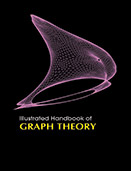Computer Science

Graphing is one of those tools that you just cannot be without. Graphs are used in everyday life, from the local newspaper to the magazine stand. It is one of those skills that you simply cannot do without. Whatever your need or calculation, if used correctly, a graph can help you and make your life simpler. The basis of graph theory is in combinatorics, and the role of “graphics” is only in visualizing things. Graph-theoretic applications and models usually involve connections to the “real world” on the one hand—often expressed in vivid graphical terms—and the definitional and computational methods given by the mathematical combinatoric and linear-algebraic machinery on the other. For many, this interplay is what makes graph theory so interesting.
Illustrated Handbook of Graph Theory provides an introduction to pure and applied graph theory with an emphasis on algorithms and their complexity.
Graph theoretical ideas are highly utilized by computer science applications. Especially in research areas of computer science such data mining, image segmentation, clustering, image capturing, networking etc., For example a data structure can be designed in the form of tree which in turn utilized vertices and edges. Similarly modeling of network topologies can be done using graph concepts. In the same way the most important concept of graph coloring is utilized in resource allocation, scheduling. Also, paths, walks and circuits in graph theory are used in tremendous applications say traveling salesman problem, database design concepts, resource networking. This leads to the development of new algorithms and new theorems that can be used in tremendous applications.
Illustrated Handbook of Graph Theory will serves as a foundation for a variety of useful applications of graph theory to computer vision, pattern recognition, and related areas.
This illustrated handbook is intended to students who want to learn the basics of Graph Theory. Graph Theory has a wide range of applications in engineering and hence, this handbook will be quite useful for readers who are into Language Processing or Computer Networks, physical sciences and numerous other fields.